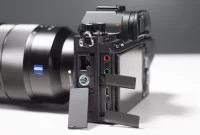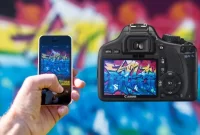The rise of smartphones has revolutionized photography, posing a challenge to traditional cameras. This article aims to evaluate the future of photography by comparing cameras against the advanced capabilities of smartphones.
Advancements in Smartphone Camera Technology
In recent years, we have witnessed remarkable advancements in smartphone camera technology, revolutionizing the way we capture and preserve our precious moments. The integration of advanced imaging sensors, powerful processors, and innovative software has considerably narrowed the gap between traditional cameras and smartphones.
One of the most significant developments is the improvement in image quality. Smartphone cameras now boast higher megapixel counts, allowing for sharper and more detailed photos. Additionally, advancements in image processing algorithms have made it possible to capture images with better dynamic range and low-light performance.
Another area of progress is the enhancement of optical zoom capabilities. While traditional cameras have long offered optical zoom options, smartphones have historically relied on digital zoom, which often resulted in a loss of quality. However, manufacturers have introduced dual-camera setups with telephoto lenses, enabling smartphones to achieve true optical zoom without sacrificing image quality.
Furthermore, the advent of artificial intelligence (AI) has ushered in groundbreaking features for smartphone photography. AI-powered camera systems can now automatically detect scenes, optimize settings, and even apply real-time image enhancements. This technology has made capturing professional-looking photos more accessible to the average user.
Smartphone cameras have also embraced the trend of computational photography. By leveraging algorithms and machine learning, smartphones can now capture multiple exposures and combine them into a single, high-quality image. This technique enables users to achieve stunning portraits with blurred backgrounds, simulate long-exposure shots without a tripod, and even capture impressive night shots.
As we look ahead, the future of smartphone camera technology appears promising. We can anticipate further advancements in computational photography, such as improved multi-frame noise reduction and advanced depth sensing for realistic augmented reality experiences. Additionally, the integration of more sophisticated sensors and optics will continue to push the boundaries of smartphone photography.
In conclusion, the advancements in smartphone camera technology have led to a remarkable transformation in the world of photography. With ever-improving image quality, optical zoom capabilities, AI-powered features, and computational photography techniques, smartphones have become formidable contenders to traditional cameras. As we progress, it is exciting to ponder the endless possibilities that lie ahead for smartphone photography.
The Limitations of Smartphone Cameras
Smartphone cameras have undoubtedly revolutionized the way we capture and share moments. Their convenience, portability, and ever-improving image quality have made them the go-to choice for many people. However, it is important to recognize that smartphone cameras also have their limitations.
Limited Zoom Capability
One of the major limitations of smartphone cameras is their limited zoom capability. Unlike dedicated cameras with optical zoom lenses, smartphones rely solely on digital zoom, which often results in pixelated and blurry images when zoomed in. This limitation makes it challenging to capture high-quality, detailed shots of distant subjects.
Poor Low-Light Performance
While smartphone cameras have made significant advancements in low-light photography, they still struggle to match the image quality produced by professional cameras in low-light conditions. Their small image sensors and limited aperture sizes make it difficult to capture sharp and noise-free images in dimly lit environments.
Limited Manual Controls
Another limitation of smartphone cameras is the lack of manual controls. While some smartphone models offer manual settings like ISO and white balance adjustments, they are often limited in functionality and are not as precise and customizable as those found in dedicated cameras. This can be a hindrance for photography enthusiasts who prefer to have full control over their image settings.
Overall Image Quality
Despite the continuous improvement in image sensors and image processing algorithms, smartphone cameras still generally cannot match the image quality produced by dedicated cameras. Dedicated cameras often have larger sensors, better lens quality, and more advanced image processing capabilities, resulting in higher resolution, better dynamic range, and overall superior image quality.
In conclusion, while smartphone cameras have undoubtedly become more capable and convenient, they still have limitations that restrict their ability to fully replace dedicated cameras. Recognizing these limitations is essential for individuals who want to capture professional-quality photographs or require more control over their image settings. As technology continues to advance, it will be interesting to see how smartphones and dedicated cameras evolve and complement each other in the future of photography.
The Evolution of Mirrorless Cameras
Mirrorless cameras have revolutionized the world of photography, offering a compelling alternative to traditional DSLRs. These lightweight and compact cameras have become increasingly popular among professional photographers and enthusiasts alike.
One of the key advancements in mirrorless cameras is the absence of a mirror box and optical viewfinder found in DSLRs. Instead, they utilize an electronic viewfinder (EVF) or a rear LCD screen, providing instant feedback on the exposure and settings, allowing photographers to make quick adjustments.
Another major development is the improvement in autofocus technology. Mirrorless cameras now feature faster and more accurate autofocus systems, utilizing advanced algorithms and sensors. This enables photographers to capture sharp images, even in challenging conditions or fast-paced situations.
Furthermore, mirrorless cameras have witnessed significant progress in terms of image quality. With larger sensors and advanced image processing algorithms, these cameras produce high-resolution images with exceptional detail and dynamic range.
Additionally, the versatility of mirrorless cameras has expanded with the introduction of interchangeable lenses. Photographers can now choose from a wide range of lenses to suit their specific needs, whether it’s capturing landscapes, portraits, or wildlife.
Moreover, the advancements in video capabilities cannot be overlooked. Mirrorless cameras now offer impressive video recording capabilities, including high-definition and even 4K resolution. This has made them a popular choice among videographers and content creators.
In conclusion, mirrorless cameras have come a long way since their inception. The evolution of these cameras has transformed the photography industry, offering professional-grade performance in a compact and portable package. As technology continues to advance, we can expect further innovation in mirrorless camera technology, pushing the boundaries of what is possible in the world of photography.
The Role of Artificial Intelligence in Photography
Artificial Intelligence (AI) is revolutionizing various industries, and photography is no exception. With the rapid advancements in technology, AI has become an indispensable tool for photographers, allowing them to take their creativity to new heights.
One of the key roles of AI in photography is enhancing image quality. Through intelligent algorithms, AI can automatically correct and enhance images, improving details, colors, and overall aesthetics. This simplifies the post-processing workflow, saving photographers valuable time and effort.
AI also plays a crucial role in image recognition and categorization. By analyzing vast amounts of data, AI can accurately identify objects, scenes, and even people in images. This automation simplifies the image organization process, making it easier for photographers to search, sort, and retrieve their photos.
Furthermore, AI-powered cameras are becoming increasingly prevalent. These cameras can automatically adjust settings such as exposure, focus, and composition, based on the scene being captured. This enables photographers of all levels to capture stunning images effortlessly, even without extensive technical knowledge.
Moreover, AI is driving innovation in the field of computational photography. By combining multiple images or using algorithms to generate additional data, AI can create high-resolution images, simulate depth of field, or even remove unwanted objects from photos. This opens up new creative possibilities for photographers.
Looking ahead, the role of AI in photography is set to expand further. Machine learning algorithms will continue to learn from vast datasets, leading to more accurate and personalized image enhancements. AI will also play a significant role in the development of intelligent cameras that can understand the photographer’s intent and produce images accordingly.
In conclusion, artificial intelligence has revolutionized the photography industry. It has become an invaluable tool for enhancing image quality, automating tasks, and enabling photographers to explore new creative avenues. As technology continues to advance, the role of AI in photography is only set to become more prominent.
Conclusion
The future of photography is evolving with the rise of smartphones, challenging traditional cameras. While smartphones offer convenience and advanced technology, dedicated cameras still excel in terms of image quality and versatility. Ultimately, the choice between a camera and a smartphone depends on individual needs and preferences.




